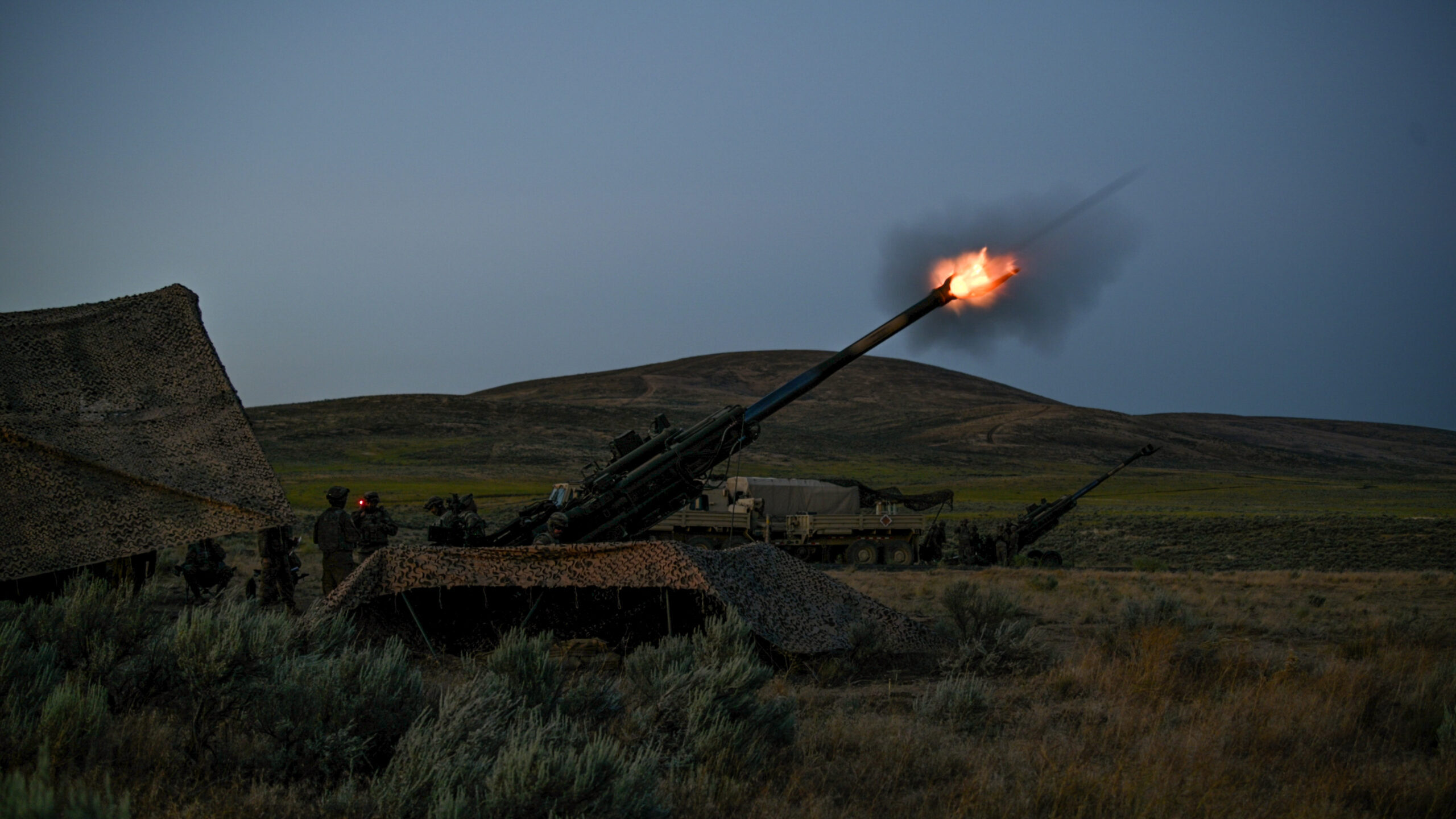
Charlie Battery, 2nd Battalion, 218th Field Artillery Regiment, 41st Infantry Brigade Combat Team (IBCT), Oregon National Guard fires their M777 155mm Howitzer at Yakima Training Center, Wash., on July 13, 2022. (Maj. W. Chris Clyne, US Army National Guard)
WASHINGTON — The Army’s top acquisition official said today he’s “not uncomfortable” with the state of Army munitions stockpiles in the wake of months of arms transfers to Ukraine, but said the Army is doggedly working with industry — including potentially offering multi-year procurement contracts — to boost the production of certain weapons systems to keep Kyiv armed and the US well stocked.
Doug Bush, assistant secretary of the Army for acquisition, logistics and technology, told reporters that he spends the bulk of his time working to expand US production of 155mm artillery, High Mobility Artillery Rocket System (HIMARS) launchers, Guided Multiple Launch Rocket Systems (GMLRS) or Javelins that have so critical to Ukraine’s recent successes against Russia. Specifically, Bush said the Army was aiming to “dramatically increase” production of GMLRS and is “doubling or more than doubling” production rates for HIMARS launchers.
To accomplish that, Bush said, the Army is leaning on congressional support, and also on the defense industry. For that latter, Bush said the Army — and the Pentagon — was considering the use of multi-year procurement contracts that could help assuage contractor fears of unstable markets for the systems. Bush’s comments came after the Pentagon’s chief weapons buyer, Bill LaPlante, signaled the Defense Department was open to multi-year arrangements.
“Industry, if they have a guaranteed five-year production run for something, they can actually buy in quantity and manage supply lines more efficiently, so yes,” Bush said. “We have to ask and Congress has to approve, but multi-year for certain things would certainly make a lot of sense in my view, but there’s a lot of other people who are going to contribute to that decision.”
Since Russia invaded Ukraine on February 24, the Defense Department has sent $14.5 billion in military aid to the Ukrainians, drawn from US stocks and in direct orders from contractors. The Pentagon has so far sent 8,500 Javelins, 1,600 Stingers, 16 HIMARS and about 807,000 rounds of 155mm artillery for 126 155mm howitzers, according to a Sept. 8 fact sheet from the Pentagon. The US has also sent GMLRS, the munition for the HIMARS.
The transfer of US inventories of weapons and ammo to Ukraine has raised concerns about the amount left in US stocks. And while Bush said he wasn’t uncomfortable with the Army’s stocks in general, he later dodged a question about whether the Army had enough ammunition if a large-scale conflict broke out soon, stating that it’s a question for the chief of staff of the Army and secretary of the Army.
Bush, instead, focused on how he said the Army was working to replenish what’s been transferred, and who he said could help while the Army ramps up.
“So those efforts are our number one course of action right now that we’re focused on, to provide … three things: increased production for supporting Ukraine, replenishing our own stocks, and then setting ourselves up to be able to provide [and] be able to respond to additional allies requests outside of Ukraine,” he said.
While the Army is aiming to boost production rates domestically, Bush said the goal production rates the service aimed for are still in the “high number of months to a year” out, making the production partnerships and donations more important.
Therefore, Bush said another “major” line of effort was working with allies to take advantage of their industrial capacity to make munitions, such as the 155mm, with a third line of effort focused on pushing allies to donate equipment to Ukraine.
“In the meantime, that’s why those other lines of effort are so important,” he said. “Using our allies who in some cases can produce more quickly because they have facilities are not using it all. And then getting our allies to donate as well to reduce the demand that we have to provide.”
For the 155mm artillery, the Wall Street Journal reported that defense officials were concerned that the stocks were “uncomfortably low,” but not critically low.
On Tuesday, the Defense Department announced that it had awarded a $311 million contract for Javelins to the Raytheon and Lockheed Martin joint venture that produces the weapons system. The contract procure Javelins for Lithuania and Jordan, but includes 1,800 Javelins to replenish rounds sent to Ukraine.
“As Javelin continues to demonstrate its reliability and effectiveness, its reputation as the premier battle-proven, fire-and-forget precision anti-armor weapon grows,” said Marek Wolert, Javelin joint venture president and Raytheon Missiles & Defense’s javelin program director, in a statement. “Our commitment to delivering this exceptional weapon system to global ground forces is unwavering.”
Bush told reporters that there were more Javelin contracts coming to replenish stocks sent to Ukraine, adding that the Army is looking to get over $1 billion worth of Javelins on contract by the end of fiscal 2023. He added that the service was “dramatically increasing” Javelin production year over year as well.
“We’ve got to replace thousands and we also want to set the stage for increased production for allies,” Bush said.
‘AI-BOM’ bombs: Army backs off, will demand less detailed data from AI vendors
Instead of demanding an exhaustive “AI Bill of Materials.” the Army will only ask contractors for a “baseball card” of key stats on their AI — while building up its in-house capacity to check for bad code or “poisoned” data.


























